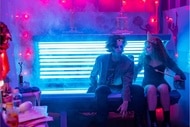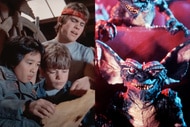When did The Simpsons' Treehouse of Horror episodes stop parodying horror?

The latest Treehouse of Horror episode of The Simpsons — the longrunning series’ 31st Halloween special — is a little strange. Like the three decades of Treehouse of Horror before it, the upcoming, slightly delayed episode eschews a “normal” story about Springfield’s favorite family and instead tells three shorter stories, all spooky parodies. The issue with “Treehouse of Horror XXXI,” which will air on Nov. 1 on Fox, is that none of the things its parodying are actually, well, horror. It’s a curious development, one that’s not entirely bad and perhaps makes sense given The Simpsons’ recent history.
Regardless of where you stand in the debate about whether or not The Simpsons is good anymore (and the related discussion of just when, exactly, it stopped being good), “Treehouse of Horror XXXI” is odd. It’s not a bad half-hour of TV, though it indisputably falls far short of the series’ glory days. The three things it parodies — Toy Story, Spider-Man: Into the Spider-Verse, and a Russian Doll-esque time-loop story — are in no way horror. The episode turns them into horror (the first Pixar-inspired segment “Toy Gory” casts Bart as a Sid-type who mutilates his toys only to be mutilated in return), but it feels like there’s something missing.
The first Treehouse of Horror aired as part of The Simpsons’ sophomore season back in 1990. It was a humble beginning that spoofed haunted houses as a general trope rather than a specific story, including Edgar Allen Poe’s The Raven and “To Serve Man,” an iconic episode of The Twilight Zone. The Treehouse of Horror would go back to The Twilight Zone pretty much every year for the next decade, with segments spoofing “It’s a Good Life,” “Nightmare at 20,000 Feet,” “Little Girl Lost,” and “Living Doll,” to name a few. Other segments would parody classic bits of horror like King Kong, The Fly, or Dracula, while still others aped iconic, foundational horror stories like “The Monkey’s Paw” or Ray Bradbury’s “A Sound of Thunder.”
For the most part, the first decade of Treehouse of Horror was riffing on timeless spooks, stories that feel so archetypical that they’re just accepted as part of the genre’s basic vocabulary. The segments spoofing The Twilight Zone are an excellent example. At this point, it seems likely that far more people have seen the Simpsons episode where a Krusty the Clown doll tries to kill Bart than have seen the 1963 Twilight Zone episode with “Talky Tina.” That might even be to the Treehouse of Horror’s benefit, as The Simpsons’ writing staff knew that so many of the stories from Rod Sterlin’s classic series were cultural touchstones rife for The Simpsons to put its own stamp on. These episodes are clearly lovingly indebted to the source material they’re parodying, but the ubiquity of those stories and tropes gives so much room for The Simpsons to put its own iconic spin on the material.
Going down the list of Treehouse of Horror episodes, you’ll start to see a gradual phasing out of Twilight Zone parodies and the addition of more recent horror and sci-fi titles. These films, like I Know What You Did Last Summer, The Terminator, and E.T. the Extra-Terrestrial, are classics in their own right, but they’re not as much of an inherent part of the fabric of horror as many of the earlier parodied works were. The Treehouse of Horror parodies are reflective of this — pretty good and pretty funny, but somehow not themselves elevated to that timeless level of earlier installments.
Season 13’s “Treehouse of Horror XII” in 2001 also arguably marks when the Halloween special first parodied something that wasn’t explicitly horror in its Harry Potter spoof. That segment “Wiz Kids” is worthwhile if for no other reason than a pretty horrific image of Smithers doing vore. It would be followed, though, by an increasing number of non-horror Treehouse of Horrors. Sure, there are still old classic spoofs thrown in there, but for every riff on The Blob, “The Most Dangerous Game,” or Freaks, there’s also a parody of Transformers, The Cat in the Hat, and perhaps most perplexingly, Mr. and Mrs. Smith.
These non-horror parodies can work, especially the more recent episodes that have used them as an opportunity to experiment with style and format, like The Cat in the Hat segment or this year’s Toy Story send-off. Still, there’s just something that feels a bit, well, forced.
While early Treehouse of Horrors were a seemingly effortless blend of timeless horror and The Simpsons’ humor, these newer segments have to do the work of not only parodying a work and populating it with the Simpsons characters we know and love, but then making that parody scary. It’s trying too much, as evidenced by "Into the Homerverse," the new episode’s Spider-Verse parody that doesn’t have the room to be a good Spider-Man parody, a good horror, or even a good Simpsons episode.
And, yes, complaining about how The Simpsons isn’t good anymore is just a tired and awful way to spend your limited time on this Earth. That’s not what this is about. And yet, it’s hard to look at the past 30 years of Treehouse of Horrors and not see that something has changed. Why is The Simpsons looking to more esoteric, non-horror titles for inspiration rather than the classic Twilight Zone-era of horror of yore? Do the writers think that modern audiences want more modern or surprising touchstones rather than parodies of old black-and-white TV? Perhaps the current crop of writers doesn't have the same connection to old horror as the people who were writing Treehouse of Horrors a literal generation ago. Maybe they just want to try something new — and you can’t blame them for that. Still, it’s hard to deny that there’s a definite link between Classic Horror and Classic Simpsons.




























